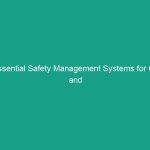Introduction
Good morning team! Today, we’re going to discuss a crucial topic that directly impacts our health and Safety on the job: Must-Know Silicosis Guidelines. Silicosis is a serious lung disease caused by inhaling fine silica dust, which is common in various industries. Understanding how to protect ourselves from these hidden risks is vital not only for our health but also for ensuring a safe working Environment for everyone.
In this Toolbox Talk, we’ll cover what silicosis is, the risks involved, best practices to prevent it, and the Regulations we must adhere to. Let’s dive in!
Understanding Silicosis
Silicosis is a progressive and incurable lung disease caused by inhaling respirable crystalline silica dust. This dust is often found in materials such as sand, rock, and concrete. When workers are exposed to this dust over time, it can lead to serious health complications, including chronic coughing, shortness of breath, and ultimately, respiratory failure.
Many people believe that silicosis is only a concern in certain industries, such as mining and construction. However, it can affect workers in various fields, including glass manufacturing, stone cutting, and even some agricultural operations. This misconception can lead to inadequate Safety Measures and increased risks.
Key Hazards, Risks, and Safety Considerations
Understanding the key Hazards associated with silica exposure is essential for protecting yourself. Here are some specific risks:
- Inhalation of Silica Dust: The primary risk involves inhaling fine particles that can penetrate deep into the lungs.
- Duration of Exposure: Prolonged exposure increases the likelihood of developing silicosis.
- Workplace Environment: Enclosed spaces with poor ventilation can exacerbate exposure levels.
The consequences of ignoring safety protocols can be dire. Employees may experience chronic health issues, which not only affect their quality of life but can also lead to increased absenteeism and reduced productivity in the workplace.
Best Practices, Procedures, & Actionable Advice
Now that we understand the risks, let’s discuss the Best Practices and Procedures we can implement to safeguard ourselves from silicosis:
- Use Proper Personal Protective Equipment (PPE): Always wear appropriate respirators when working in areas where silica dust is present. Ensure that the equipment is properly fitted and maintained.
- Implement Engineering Controls: Use water sprays or ventilation systems to minimize dust generation. Enclosed systems are also beneficial in limiting exposure.
- Conduct Regular Training: Participate in training sessions that focus on recognizing silica hazards and using safety equipment correctly.
- Practice Good Hygiene: Wash hands and face thoroughly before eating or drinking, and avoid eating in dusty areas to prevent ingesting silica dust.
Let’s take a moment to review a real-life example. In a recent incident at a construction site, a lack of proper ventilation led to elevated silica dust levels. Workers reported respiratory issues, prompting an investigation. The findings revealed that the company had overlooked necessary engineering controls, highlighting the importance of adherence to safety protocols.
Regulations, Standards, and Compliance
Compliance with safety regulations is critical in preventing silicosis. The Occupational Safety and Health Administration (OSHA) has established permissible exposure limits (PELs) for silica dust. Familiarizing yourself with these Standards ensures that we maintain a safe working environment.
Additionally, the following regulations and standards should be adhered to:
- osha Silica Standard (29 CFR 1926.1153): This standard outlines the requirements for reducing silica exposure in construction and other industries.
- National Institute for Occupational Safety and Health (NIOSH): NIOSH provides guidelines and recommendations for silica exposure limits and safety practices.
Understanding and following these regulations helps protect not only ourselves but also our coworkers and the community at large.
Employee Engagement & Discussion
Now that we’ve covered the essential guidelines on silicosis, let’s open the floor for discussion. Here are a few questions to get us started:
- What specific challenges have you faced regarding silica exposure in your job?
- How can we improve our existing safety protocols to better protect ourselves from silica dust?
- Are there any additional resources or training you feel would be beneficial?
Feel free to share your thoughts and experiences. Remember, your input is invaluable in creating a safer workplace.
Conclusion & Key Takeaways
In conclusion, understanding and applying the Must-Know Silicosis Guidelines is essential for our health and safety. By recognizing the hazards, following Best Practices, and adhering to regulations, we can significantly reduce the risks associated with silica exposure.
Let’s commit to prioritizing safety in our daily operations. Thank you all for your attention and for your ongoing commitment to maintaining a safe working environment. Remember, safety is a collective responsibility!


